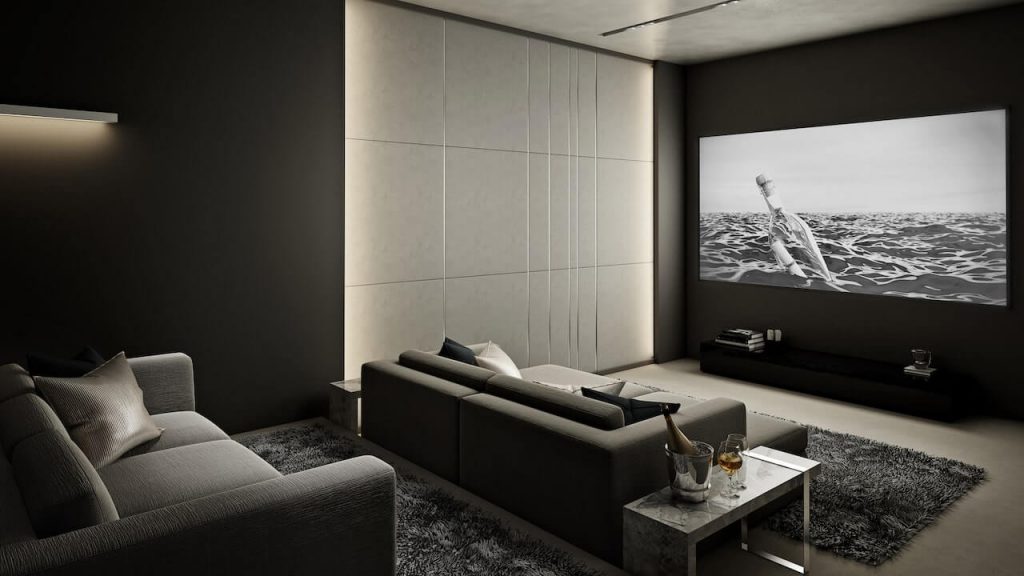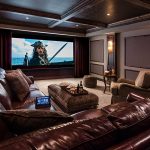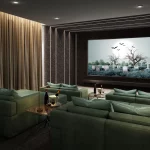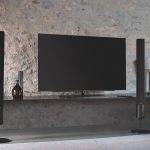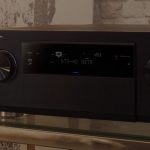If your dream in the drawer has always been to build a home cinema room at home, but you’ve never known where to start, this article is exactly for you!
In fact, we wanted to create a comprehensive guide aimed at all those who would like to untangle the world of home cinema, helping them to better understand some essential concepts, whether they want to attempt the design on their own or outsource the work to an expert.
Indeed, it is impossible to think of achieving a professional-level, bug-free result and thus replace those who have been doing this job for years and have acquired skills through study and experience in the field.
But we are aware that there are many who dream of a space dedicated to Cinema within their own home walls. So here’s a light overview for you to shed some light on the world of Home Cinema.
Let’s get started!
An ever-evolving technology

The ways in which audiovisual products are enjoyed are constantly changing. Technological evolution is advancing relentlessly among various media, entertainment, and the way they are perceived and used by audiences.
In recent years, the cinema has no longer been just the only place to see a movie (or a movie premiere), but a place to have a collective experience.
Today things have changed even more.
In recent months we have realized one thing: that perhaps, in the future, we should become accustomed to a form of home entertainment, without totally excluding the experience that a place like the cinema offers, but having the possibility of recreating this experience within our own home walls.
The dream of many is therefore to have an ad hoc space. A place where they can devote time to themselves or with company and be able to enjoy movies and TV series with the audio and video quality that this experience requires.
But the question many people are asking is: how do I set up a home cinema room? What precautions do I need to take into account? How can I design this space myself?
Let’s get some clarity.
Difference between Home Cinema and Media Living Room
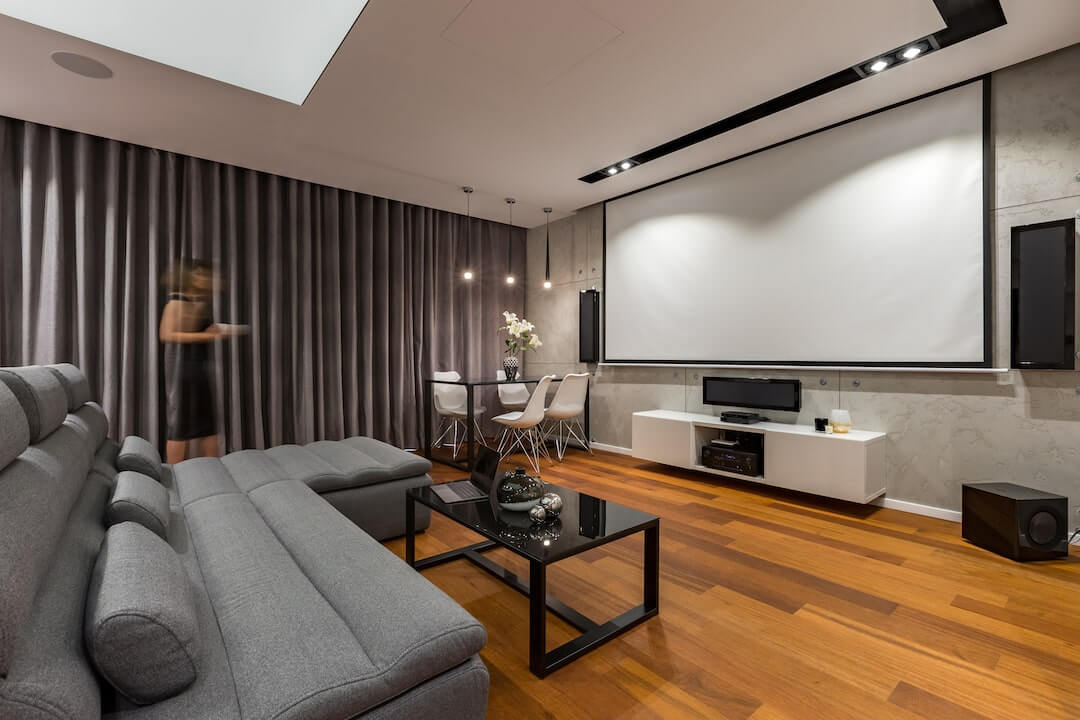
A Home Cinema room is defined as a room dedicated exclusively to the enjoyment of audio-video content. A place where the user can have an experience similar to that of the movie theater, but with all the comforts of home.
It requires a higher budget than the Media Living Room, more preparation and expertise, but while requiring a project that starts from the ground up, existing locations in one’s home (such as the basement or an additional bedroom) can be adapted for this type of room.
Whereas, the term Media Living Room refers to a mixed room that has several domestic functions. Not a room completely dedicated to cinema, but a room, a living room in fact, in which normal family activity already takes place, but which also has the function of a cinema room in addition.
Initial organization and material procurement
When deciding to set up a home cinema room, you need to dwell on two basic factors before taking action: you need to clear your head and find all the materials.
You are about to face a big challenge and it is easy to get confused.
The most obvious solution, of course, is always to rely on experts for advice and entrust them with this work by investing some money and then get a professional result without wasting time, but even in this case it is good to have some knowledge about everything related to home cinema.
First of all, what should be clear is that Home Cinema is a system, an environment consisting of a set of elements in harmony with each other.
These elements are:
- The environment
- The sittings
- The video source
- The sound system
The environment
When deciding on the most suitable room for home cinema, 4 elements should be taken into account, namely:
- The size
- The shape
- The position
- Soundproofing
The size
Basically, the question regarding the size (but actually also the shape) of the room that will become our entertainment venue is closely related to the choice of technology to be used (screen, projector, speakers…) and sound propagation.
There are no one-size-fits-all dimensions; each room is its own case. For those who decide to adapt an existing space rather than build it from scratch, it is much easier to work on the other elements while leaving the dimensions unchanged.
The shape
Sound is an oscillation of particles within a propagating medium. It starts from a source and propagates through vibratory motions, producing air displacements and bouncing off or through surfaces.
If you do not anticipate the way sound behaves within the environment, you run the risk of running into reflection “errors” that can produce unwanted echoes, volume elevations, and high than necessary sound duration.
To avoid this, the advice is to avoid symmetry, i.e., similar lengths of the sides of the room, such as the cubic shape.
The position
That is, the position of the room in relation to the house.
Although compulsory action will also have to be taken on sound insulation, it is always advisable to keep the home cinema room away from the bedroom or living room.
Usually the basement is the ideal location (also for a discourse related to wiring and possible wall abatement)
Soundproofing
That is, a set of interventions aimed at limiting the propagation of sound to adjacent rooms (and also improving indoor performance).
Sound insulation interventions will be used to avoid those “errors” of sound reflection by putting into practice attenuation in order to limit the kinetic force of sound, adding thickness to the walls of the room, using a plasterboard wall placed inside the existing one and filling in any empty space, sealing the room to prevent sound from propagating outward.
The sitting

Usually, the average configuration includes 2 rows of 2-seat seats, but also 2 rows of 3 seats, or 3 rows of 3 or 5 seats, depending on the space available.
What you absolutely must remember is that the ideal seating arrangement in the home cinema room is closely related to other factors such as the size of the room, the amount of seats you want to add, the width of the display, the sound system used, and the number and placement of speakers.
Another important detail: armchairs are built to be super comfortable, to make you want to stay seated while watching a movie or TV series.
Therefore, you can choose from many models with a variety of comforts.
The video
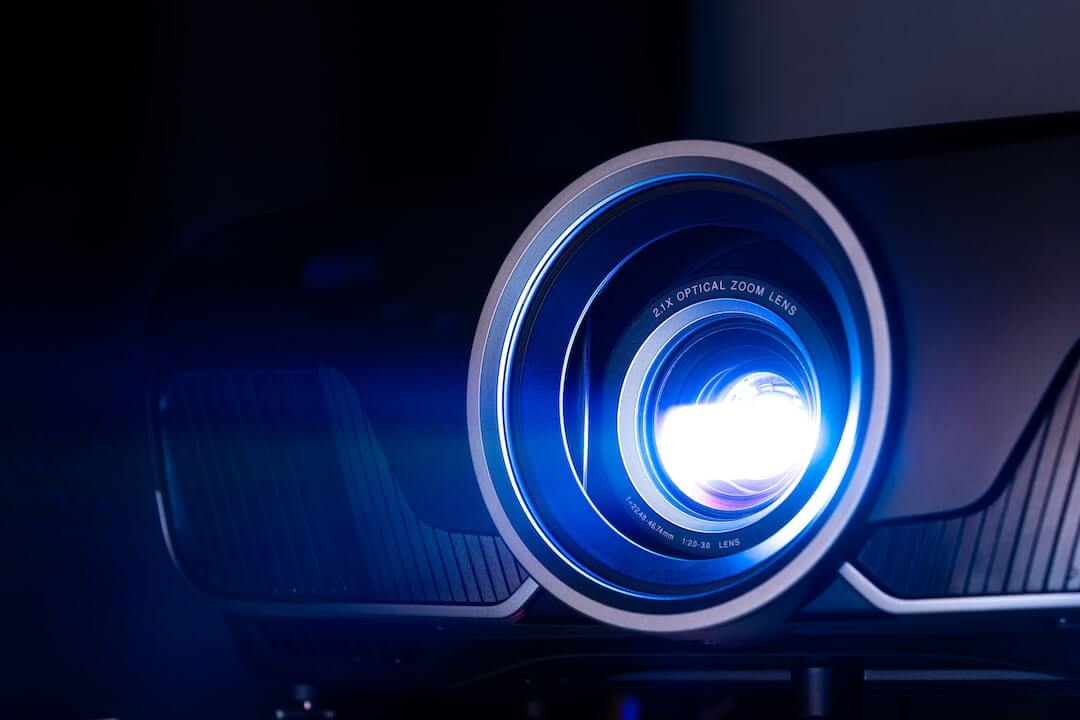
Here we come to the question regarding which video source to choose for one’s home cinema room.
The discussion at this point is very simple because the choice falls between:
- The TV
- The projector and its screen.
But let’s go in order.
The TV
We all know that today’s technology offers a very wide choice of ultralight TVs from different formats and technologies.
Choosing the most suitable TV for one’s needs therefore is not so simple and involves research work taking into account factors such as the video format and the technology best suited to one’s needs.
These technologies at present are:
- LCD
- LED
- OLED
- Quantum Dot
LCD and LED are very similar to each other; the latter is an evolution of LCD that provides better brightness distribution.
They are both capable of providing an exceptional level of brightness without impacting panel thickness while keeping power consumption reasonably low.
The trade-off lies in lower image precision in busy scenes.
QLED or Quantum Dot is a further evolution of LED technology that, through the use of nano-crystals within each pixel, allows for a much wider range of colors.
The result returns a much brighter image with realistic colors.
OLED is the latest in TVs: it consumes little power, offers excellent contrast and brightness, a much higher level of detail than LCD in scenes with lots of action, and excellent blacks. However, it costs quite a bit more, for the same inches, and has a considerably shorter operating life.
The Projector
There are 3 main types of projectors:
- DLP
- LCD
- LCoS
DLP (Digital Light Processing) technology is one of the most popular, cheapest and requires little space and almost no maintenance.
It is ideal for home use and for those with low demands.
The image it projects is very sharply defined and free of dither defects, but in some cases it may create what is called a “rainbow effect,” which is a kind of color flicker that can fatigue the eye in the long run.
LCD (Liquid Crystal Display) technology, on the other hand, creates very believable natural hues and a high-quality color sequence while still slightly gradating in black saturation
If we talk about performance, LCD projectors fall somewhere between DLPs and LCoSs: they are not as bright as the latter, but they are brighter than DLPs.
Exactly like LCDs, LcOS projectors emit light through a panel that creates the image. This light, however, is first reflected by this panel allowing for better black color quality. All this makes for a more immersive viewing experience. In addition, another advantage is that the sidebars of the formats in CinemaScope disappear completely making viewing even more enjoyable.
But LCoS do not offer the same brightness levels offered by DLPs and LCDs, so they are recommended for use only in rooms with perfectly dark rooms and medium to small screens.
Lamp, LED or laser?
LED or laser technology is clearly taking over from lamp-based technology, which is slowly becoming obsolete. The costs of these two systems are higher, but they offer considerable savings in the long run, especially in maintenance and durability.
If one is looking for quality, of these, the laser is definitely the better system.
Projection screen
In addition to projection tools, it is equally important to choose the right base on which to focus the light rays that will bring images to life.
As a general rule, there is a tendency to use panels specially made of reflective materials with a very thin structure, but not all projection screens are the same, and it is important to pay attention to several features before proceeding with any purchase.
For an accurate choice, one must first understand the format one wants: 1:1, 4:3, 16:10 or the more popular 16:9.
The choice falls on one or the other depending on the native format of the projector (if the resolution of the projector is a Full HD, so 1920×1080, it will be better to choose the 16:9 format).
But the type of screen is also very important.
We can choose from fixed screens, certainly the cheapest, but which offer a permanent solution fixed to the wall.
Then there are motorized screens, that is, screens that remain hidden all the time but can lower from the ceiling or elevate from below through a click or voice command.
Tensioned screens, i.e., screens kept in tension by a cable to prevent sagging or rippling phenomena.
There are framed screens, which are fixed screens mounted within a frame, usually made of aluminum, that allows for perfect planarity of the curtain.
Or recessed screens, which have motorized screens mounted concealed in the ceiling.
Finally, tripod screens, characterized by a three-legged support, which are useful if you want to move them frequently.
Also very important is the color of the screen: white or gray. The choice of one or the other depends on the type of light in the room since white usually matches high-contrast projectors while gray, which absorbs light better will prevent it from escaping in darker areas.
In terms of material, on the other hand, plasticized PVC is the most popular, but sometimes, depending on the configuration of the home theater room, fabric as in the cinema or fiberglass is preferred.
The Sound System

It may sound strange, yet watching a movie or TV series are experiences that involve more use of a sense such as hearing than sight. Simply put: it is the ear, more than the eye, that immerses us in the narrative. This is because it is through audio that we perceive the environment we see on the screen as if it were real and around us.
With the new systems then, it is possible to be literally surrounded with a 360° effect by the soundtrack of a movie or TV series.
A good sound system then is practically mandatory, as important as (if not more so) than high definition video.
One can opt between:
- the Soundbar
- the Speakers.
The Soundbar
It is a compact solution that integrates a series of speakers in sequence within a long, tapered cabinet. This solution makes it possible to enhance TV sound with a single connection. It is usually placed under the TV, allowing you to gain something in terms of sound output, especially in terms of power. Then, if the chosen model includes a subwoofer, you will also have more robust bass.
It is undoubtedly an inexpensive choice, easy to mount and does not require much space, but it offers almost nothing in terms of sound dynamism: the compactness, which certainly can be considered a virtue of the Soundbar, actually results in little sound coverage and incompleteness in terms of overall performance and quality.
The Speakers
With surround speakers you will undoubtedly have much more freedom and range. In fact, depending on the type of experience you want to achieve, you can choose from surround systems consisting of 2, 5, 7, up to as many as 9 speakers, to achieve 360° audio coverage.
The most popular solution is the 5.1, characterized by the placement of three central speakers, plus two rear ones and the subwoofer, but there is also the 7.1, which is a 5.1 with, in addition, two side satellites. Finally, when we talk about 5.1.2, we mean the addition of two special speakers dedicated exclusively to spatial effects such as Dolby Atmos.
Choosing a Surround system consisting of speakers for audio is undoubtedly more complex and requires better planning than simply placing a Soundbar, but the experience such systems offer is unparalleled.
Currently, the main developers of surround systems are Dolby and DTS. These are two competing formats, and although they differ, we can say that they are equivalent, that is, for every technology of one there is a counterpart of the other.
If the goal is to recreate Cinema in the home, the best solution remains the choice of a Surround system.
Conclusion

At this point we can say that we have touched on every basic point to know if you want to build a home cinema or media living room.
This guide cannot replace, as we have already said, the notions and skills of an expert, but it can point the way for those who want to approach this world.
We at Ultra Experience offer design services and can give you more information should you want to rely on competent technicians to build your room.
Our invitation is to contact us or visit our showroom.
We will be glad to help you, we are waiting for you!

